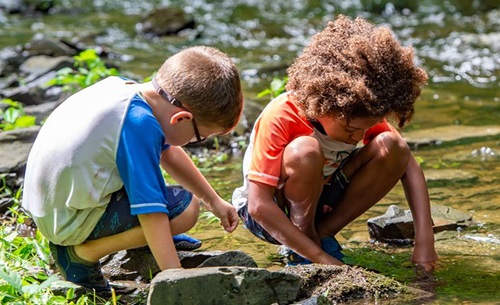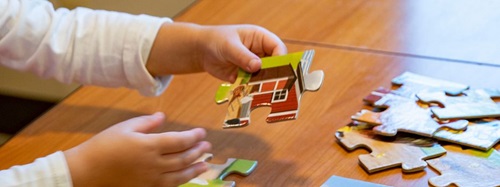The Project Approach
Using Schoolyard Ecology to Support Student Learning
|
May 2013
McLaughlin and D'Andrea are teachers at the Mission Hill School, a Boston Public Pilot School in Jamaica Plain, Massachusetts serving approximately 220 children, ages 3-14 (grades 0-8). This small learning community emphasizes a project-based, collaborative curriculum, inclusive of all learning abilities. MHS was founded in 1997 by educator and author Deborah Meier and is modeled on democratic principles.
The beauty of the Project Approach is that students can enter into learning through a wide range of experiences. There is no “one size fits all” or one right answer. At our school, children ages three through fourteen work on projects that can last a few days to a few months, or even longer. We use the Project Approach for every school-wide theme we study. Whether students are building and perfecting catapults during our study of Ancient Greece, or turning their classroom into an actual bakery when studying The World of Work, projects offer opportunities for children to get immersed in real work that brings together the mind, the hand, and the heart.
If you are new to the Project Approach, and are considering what project to explore with children, we suggest using something that is nearby, which the children can closely investigate and touch—the schoolyard. The schoolyard is often an underused resource—a resource rich with possibilities for learning. It also lends itself to a natural connection of indoor and outdoor learning.
What do you need to know?
With the Project Approach, a great deal of work goes into letting your students lead. You don’t have to know every species in the schoolyard, but you must understand that listening to your students is key. In fact, there will probably be less teacher talk and more student talk than you may be used to. You also need to know how to help them ask good questions and investigate the answers.
Where do you start?
Helping children learn to be close observers is central to this work. Before bringing your group outdoors for their first observation, have them make predictions about what they might see. Take time to talk about your bodies and your senses. What do your eyes, mouths, ears need to do? With practice, your students will build the capacity to observe closely and record their observations.
When you go outside, first let them have some time to play—to let their bodies move. That is what they will want to do. Then bring the group together and explain that the observation time is about to begin. Each student will have a clipboard, a schoolyard ecology journal, and a pencil or colored pencils. Have each child find a spot to sit quietly for a certain amount of time—maybe 5 minutes to begin with, perhaps 10 to 15 minutes, depending on your group.
We have found that bringing journals outside, and spending time observing closely and recording what you see, helps many students become better writers.
I saw a butterfly. It was flying all around. I was sitting on the ground when all of a sudden a little piece of grass was moving. I saw a snake. It was still. I saw a little bit of the snake. I saw the snake slither. (Evelyn, 6-years-old)
I saw clouds in the sky. I thought it was easy to reach, but I know it wasn’t easy. I saw a bird. It was cute. I think it was a robin. I also saw flowers together and thought it was cool. I saw a butterfly. (Nadia, 5-years-old)
What are the next steps?
After you have spent time outside, bring the group back to the classroom and brainstorm a list of things you saw in the schoolyard: trees, rocks, birds, snakes, and more. For emergent readers, you can make charts so they can see the picture associated with the written word, as a reference. This makes the written word accessible for all learners. Brainstorming together may lead quite naturally to a subject worth investigating.
Or, take the students out and ask them to specifically think about what questions they have. For instance, one six-year-old filled her whole page with questions:
“What do spiders eat? Do spiders eat leaves? Do spiders eat people? Do spiders eat skin? What do spiders drink? Do spiders drink water? Do spiders drink milk? Do spiders drink juice?”
We have found that five- and six-year-olds often start with questions that have yes/no answers such as “Do ants climb trees?” Starting with the questions your students have will help you know what they are interested in. Our job as teachers is to turn this interest into an inquiry that can be investigated and developed into a project.
There are many different methods of inquiry and resources around this process. We like to use the QUEST inquiry process from Project Dragonfly at Miami University in Ohio. These steps are:
- Question and Observe
- Uncover comparative questions
- Explore predications
- Start action plan and gather data
- Think hard about findings and share discoveries
One year, a group of our students was interested in the birds in the schoolyard. Kathy guided this group of ornithologists in shaping their inquiry question: “Do birds in our schoolyard prefer thistle to sunflower seeds?” She helped them set up the steps of their inquiry.
A conversation might go something like this:
Teacher: “How can we learn what the birds in the schoolyard like to eat?”
Student: “We need to go outside.”
Teacher: “Do we need to bring anything with us?”
Students: “We need paper, clipboards, and binoculars.”
Teacher: “You are talking about materials. Are there any other materials that we need?”
The conversation evolves as the students describe the kinds of bird seed they need and the teacher encourages them to think about how they will measure the bird seed, where they will place the bird seed, and how they will keep track of what gets eaten. “How will we know it is the same amount of bird seed?” she might ask. This can lead to an introduction or exploration of measuring cups, depending on the children’s prior experiences with measuring.
With this type of curriculum, small groups are investigating a range of questions all related to the central theme of the schoolyard. They take weeks and sometimes months to work on projects around their question.
Sharing what you found out: Learning through exhibition.
For young scientists a big part of this experience is sharing their work with others. Scientists publish their findings in journals. What can young scientists do? The projects are limitless:
- Turn the classroom into a research center or nature museum where family members, teachers, and other students can visit and learn
- Make replicas of animals they are studying using recycled materials, paper mache, fabric, etc.
- Make models of habitats
- Make field journals of animals in the schoolyard
- Arrange public speaking around their findings, to families, the school or even community members
Why use the project approach?
The Project Approach takes time—time for children to think deeply about one topic—a topic they can visit and revisit. It enables them to make connections, solve problems, and use their own senses to gather information. It gives the opportunity for things to not go perfectly, and for the children to rethink what they might change. As a classroom teacher, you know that time in the classroom is precious. Projects help you make the most of that time because they offer so many gains. Students will be writing, reading, researching, measuring, predicting, observing, drawing, thinking, comparing, reflecting, constructing, deciding and planning. Their vocabulary is enriched: binoculars, inquiry, predict, hypothesis, data, even ornithologist or herpetologist. These are the kinds of words your children will start to use in meaningful ways.
It is important to note that project-based learning is messy—in every sense of the word. The actual room will get messy. Hands and clothes may get messy, too. When done right, teachers should expect that things will not always go as planned. Embrace the possibility that an inquiry may have to be done several times; a model may collapse; or the plants in your grow lab may be eaten by mice! These occurrences are rich learning moments leading to new discoveries.






